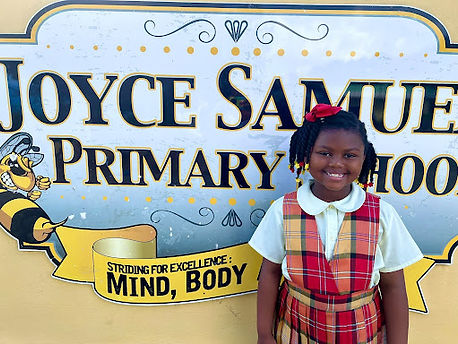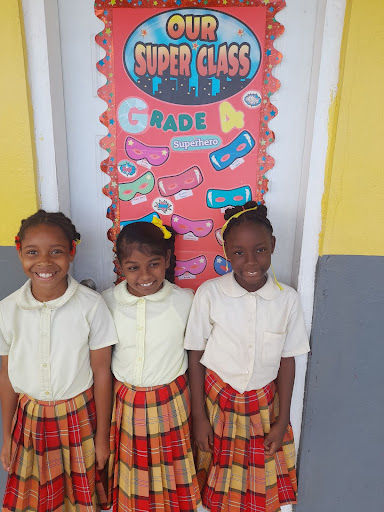
BVI National Science Fair
Team Joyce Samuel Primary

"germy hands"
Grade K-3
By: A’Laura Stoutt Chalwell
Abstract:
We all wash our hands. We know that it's good for us, and we do it because we want to keep germs away from us, especially during this time when people are being affected by the CoronaVirus. But how clean are our hands after we wash them? What if you washed your hands, but didn't dry them? Would they be less clean if you dried them with paper towels or a hand dryer? That's exactly what I wanted to find out through an experiment. My hypothesis was that your hands would be cleaner if you air dried them after washing with soap and water than if you used either a paper towel or a hand dryer. To test this, sterile cotton tip applicators were used to collect any bacteria from my hands after each method; washing and air drying, washing and towel drying, and washing and using a hand dryer. The collected samples were spread onto separate Petri dishes and placed in a dark, cool place for 24 hours.
"filter it"
Grade 4-6
By: Zuri Samuel, Jahlia Bodkin, Jomarah Russell
Abstract:
Water is one of the most important and essential resources in the world. Wherever you are, people need water to survive. Although over 75% of the Earth is made up of water, only about three percent of Earth's water is freshwater. Of that, only about 1.2 % can be used as drinking water. So what happens to those countries that do not have access to clean drinking water? They have to Filter it! Thus, the purpose of this project is to learn about filtration, what it does and how it works. Therefore, using natural materials we created a 3-D model of a water filter taking inspiration from how the earth naturally filters its freshwater sources. We then observed, tested, and compared the water before filtration and after filtration to see if our natural filter removed the impurities in the water and made it clean and drinkable.


"pollution is not the solution"
Grade K-3
By: Tianna DaSaliva, Caleb Hood and T’Koiya Daniel
Abstract:
Pollution happens when our environment is dirtied by waste, chemicals and other harmful things. It is a huge problem. Pollution can be seen in the air, found in our oceans and it even covers our land. Our lives are affected in many different ways by pollution. It is bad for our health, and the environment and is extremely harmful to our beautiful British Virgin Islands. As a way to further highlight the presence of water, land and air pollution within the territory, the grade three students of the Joyce Samuel Primary School took the initiative to create a 3D model to shed some light on this pressing issue. For this entry, the area of focus is the incinerator located in Pockwood Pond which is the territory's main location for waste disposal. The materials which were used to create this 3D model are foam board, paint, gluesticks, a glue gun, rulers, scissors, plastic containers and incense as well as props such as toy cars and plastic greenery. The intention of this model is to replicate how the incinerator affects the environment and contributes to air, land and water pollution within the British Virgin Islands.
"working escalator"
Grade 4-6
By: Nyla Gonsalves
Abstract:
An escalator is a moving staircase that carries people between floors of a building or structure. They can be used to guide people toward main exits or special exhibits. Escalators are also fun to ride especially when you are feeling tired or lazy to walk. This was the motivation that drove me to create a working escalator using recyclable materials.


"fraction game"
Grade 4-6
By: Akaelen Brewley
Abstract:
Mathematics is my favourite subject. It challenges you to think and to be a problem solver. Mathematics is made up of many different topics such as decimals, shapes and measurement, but fraction is my favourite topic. A fraction is part of a whole or a set. Fractions can be challenging for some people to understand, so with this in mind I created this fun snake and ladder fraction game to help people to fall in love with fractions like me.
"volcano"
Grade 4-6
By: K’Yona Leslie, Shauntianna Mactavious, Celinee Frank
Abstract:
A volcano is an opening in the earth’s crust through which lava, volcanic ash, and gases escape. Volcanic eruptions are partly driven by pressure from dissolved gas, much as escaping gases force the cork out of a bottle of champagne. Some well-known volcanoes around the Caribbean are Kick-‘em-Jenny 9 km north of Grenada, Soufrière Hills Volcano in Montserrat and La Soufrière volcano in St. Vincent. The La Soufrière volcano erupted in December 2020 and caused the displacement of thousands of Vincentians. We made a model using a chemical reaction between baking soda and vinegar to simulate the gas and magma flow. When the baking soda (base) reacts with vinegar (acid) it forms the gas, carbon dioxide. The gas expands and escapes through the opening of the bottle. The gas, play doe and food colouring makes foam that looks like the glowing magma in a volcano.


"bottle fan"
Grade 4-6
By: Bradd Benjamin, Bradley Smart
Abstract:
Climate change refers to long-term shifts in temperatures and weather patterns. These shifts in the weather are mainly caused by human activities such as the burning fossil fuels like coal, oil and gas. Classrooms, houses and businesses are now depending more on fans and air conditioner units to keep them cool. This is our inspiration for creating a bottle fan to keep us cool in school when it is hot without causing more damage to the environment.
"water dispenser"
Grade 4-6
By: Akaiya Bakker, Soleida Wheatley
Abstract:
All plants and animals need water to survive. Our body weight is made up of about 60 percent of water. Our bodies use water in all the cells, organs, and tissues, to help regulate body temperature and maintain other bodily functions. Because our bodies lose water through breathing, sweating, and digestion, it's crucial to rehydrate and replace water by drinking fluids and eating foods that contain water. For this reason, we decided to create a water dispenser to encourage people to drink water rather than drinking soda.


"marine ecosystem"
Grade 4-6
By: Madison Leacock, Lindsey Khablall, Aria Blyden
Abstract:
The oceans cover such a large portion of the Earth's surface that the planet has been described as the Water Planet, and it could be argued that its most widespread ecosystem is marine.Healthy marine ecosystems are important to society as they provide services such as food security, animal feeds, and raw materials for pharmaceuticals, building materials for coral and sand, and nature protection against dangers such as coastal erosion and floods. Taking all this into consideration, we decided to build this model of marine ecosystem to show interconnections between different species.
"windmill"
Grade 4-6
By: Surayya Stevens, She’Anna Stevens, A’Jhnae Dore
Abstract:
Sustainable energy sources are the need of the hour. Wind energy is a sustainable and renewable energy source, and it can generate electricity too. Wind power also comes from the sun. A wind turbine converts wind’s kinetic energy into mechanical energy. When wind touches the turbine blades, it starts rotating. Rotation of the blades turns the turbine. It also moves a drive shaft connected with the generator. The generator turns on and starts generating electricity. Turbine blades and wind speed also play a significant part in this.
.png)

"drag race"
Grade 4-6
By: Aiden Brewley, Jaylen Fahie, Jayden Fahie
Abstract:
Do you think you could build a car powered by nothing but air? A balloon-powered car is pushed forward by air escaping from a balloon, and it is fun and easy to build with materials you already have around your house. Can you imagine how you would want your own balloon-powered car to look? Can you design a car that will travel as far as possible? You can even measure your car's speed using your smartphone and a special sensor app. Get ready to grab some simple supplies to bring your idea to life!
"robot hand"
Grade 4-6
By: Jeremy Hodge
Abstract:
Visualize how cool it would be to build a robot hand that could grasp a ball or pick up a toy. In this robotics engineering project, you will learn how to use cardboard, drinking straws, sewing thread, and a little glue to make a remarkably lifelike and useful robot hand. What will you design your robot hand to do? Pick up a can? Move around a ping pong ball? It is up to you! With these starting instructions, you can design any type of hand. You will simulate human finger anatomy as the basis for a fully functional robot hand that is easy to build and does not require complicated tools.


"working kidney"
Grade 4-6
By: Lucas-Anton Findlay, Jaylani Harrigan
Abstract:
Kidneys are a very important organ in humans. It is a bean-shaped organ and is located just below the rib cage, on each side of the spine. Kidneys remove wastes and extra fluid from the body by filtering half a cup of blood every minute. The kidneys make up part of our urinary system. The urinary system is also made up of urinary bladder, urethra and ureter. With this in mind, we decided to create a model of the urinary system to encourage people to take care of their kidneys.
"rounding off bingo"
Grade 4-6
By: Deseray McMaster
Abstract:
Bingo is a fun game that lots of people love to play. It is a game of luck and chance. Bingo is an example of a game that can be played with a whole class. This was the main reason for using bingo as a backdrop of a rounding off game. Everyone is familiar with the basic rules of bingo. This game just adds a level of difficulty by having players first round off before selecting answers.
